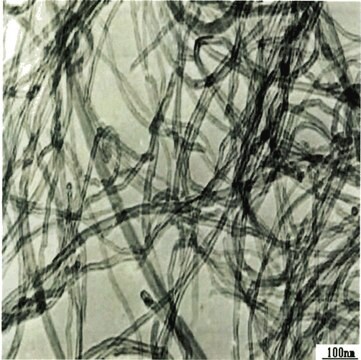406074
Carbon nanotube, multi-walled
powdered cylinder cores, 20-30% MWCNT basis, O.D. × L 7-12 nm × 0.5-10 μm, avg. no. of layers, 5 ‑ 20
Sinônimo(s):
MWCNT, MWNT, Multiwall carbon nanotube
About This Item
Produtos recomendados
Ensaio
20-30% MWCNT basis
forma
powder
Características
avg. no. of layers 5 ‑ 20
composição
carbon content, >99% TGA
D.E. × C
7-12 nm × 0.5-10 μm
Tamanho médio da partícula
−270 mesh
<53 μm
pf
3652-3697 °C (lit.)
densidade
~2.1 g/mL at 25 °C (lit.)
Procurando produtos similares? Visita Guia de comparação de produtos
Descrição geral
Aplicação
forma física
Nota de preparo
Outras notas
Código de classe de armazenamento
11 - Combustible Solids
Classe de risco de água (WGK)
WGK 3
Ponto de fulgor (°F)
Not applicable
Ponto de fulgor (°C)
Not applicable
Equipamento de proteção individual
dust mask type N95 (US), Eyeshields, Gloves
Escolha uma das versões mais recentes:
Já possui este produto?
Encontre a documentação dos produtos que você adquiriu recentemente na biblioteca de documentos.
Os clientes também visualizaram
Artigos
Carbon nanotubes (CNTs) have received much attention since their discovery in 1991 by Sumio lijima1 due to their excellent mechanical, electrical, and optical properties.
A nanocomposite is typically defined as a mixture between a host material (e.g., polymer matrix) and nanofillers with at least one dimension of less than 100 nm.
Graphene is a one-atomic-layer thick two-dimensional material made of carbon atoms arranged in a honeycomb structure. Its fascinating electrical, optical, and mechanical properties ignited enormous interdisciplinary interest from the physics, chemistry, and materials science fields.
Single-walled carbon nanotubes (SWCNTs) are promising materials for use in the active channel of field-effect transistors (FETs), photoabsorbing layers of solar cells and photodetectors because of their ultrafast charge transport mobility.
Nossa equipe de cientistas tem experiência em todas as áreas de pesquisa, incluindo Life Sciences, ciência de materiais, síntese química, cromatografia, química analítica e muitas outras.
Entre em contato com a assistência técnica




